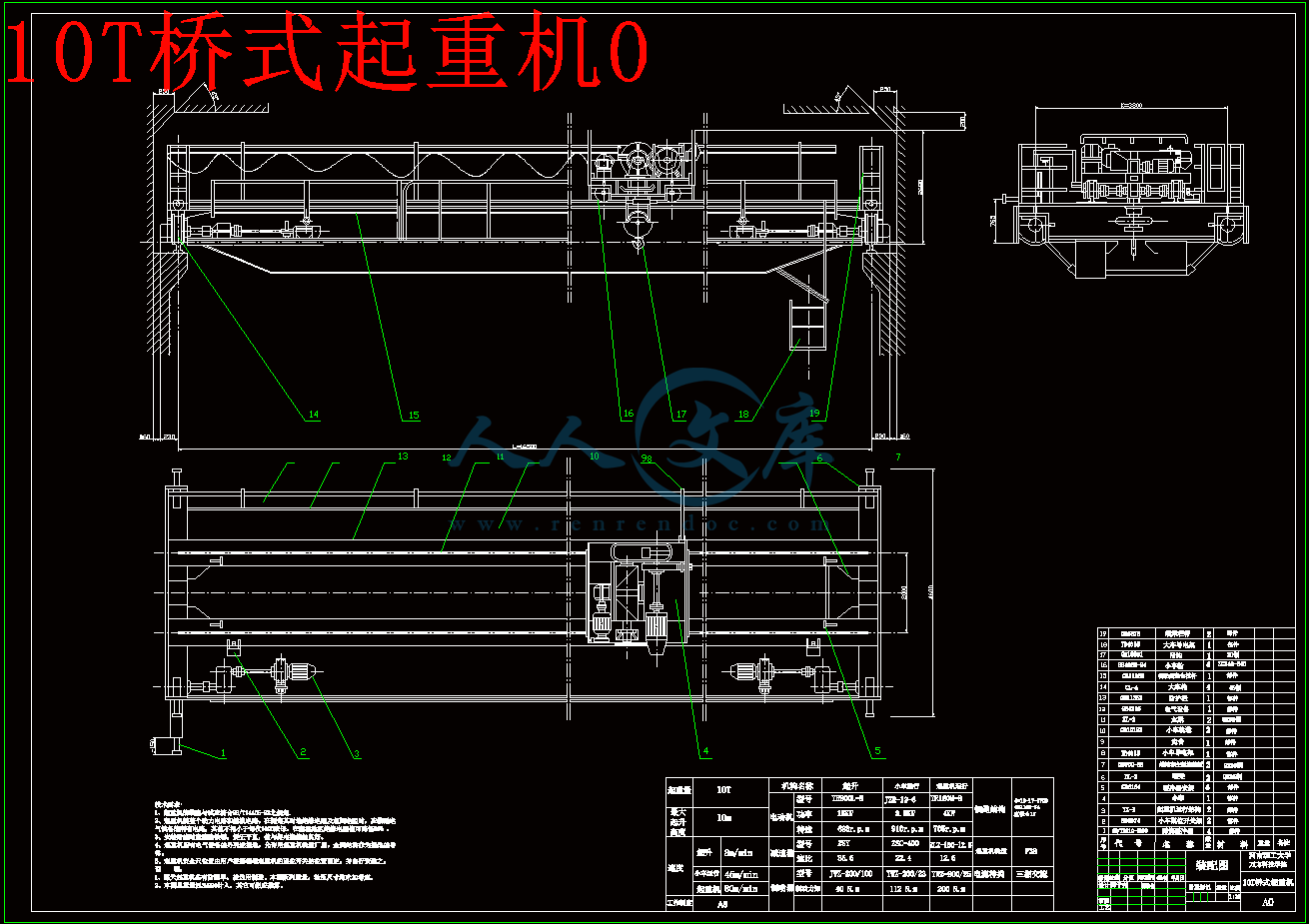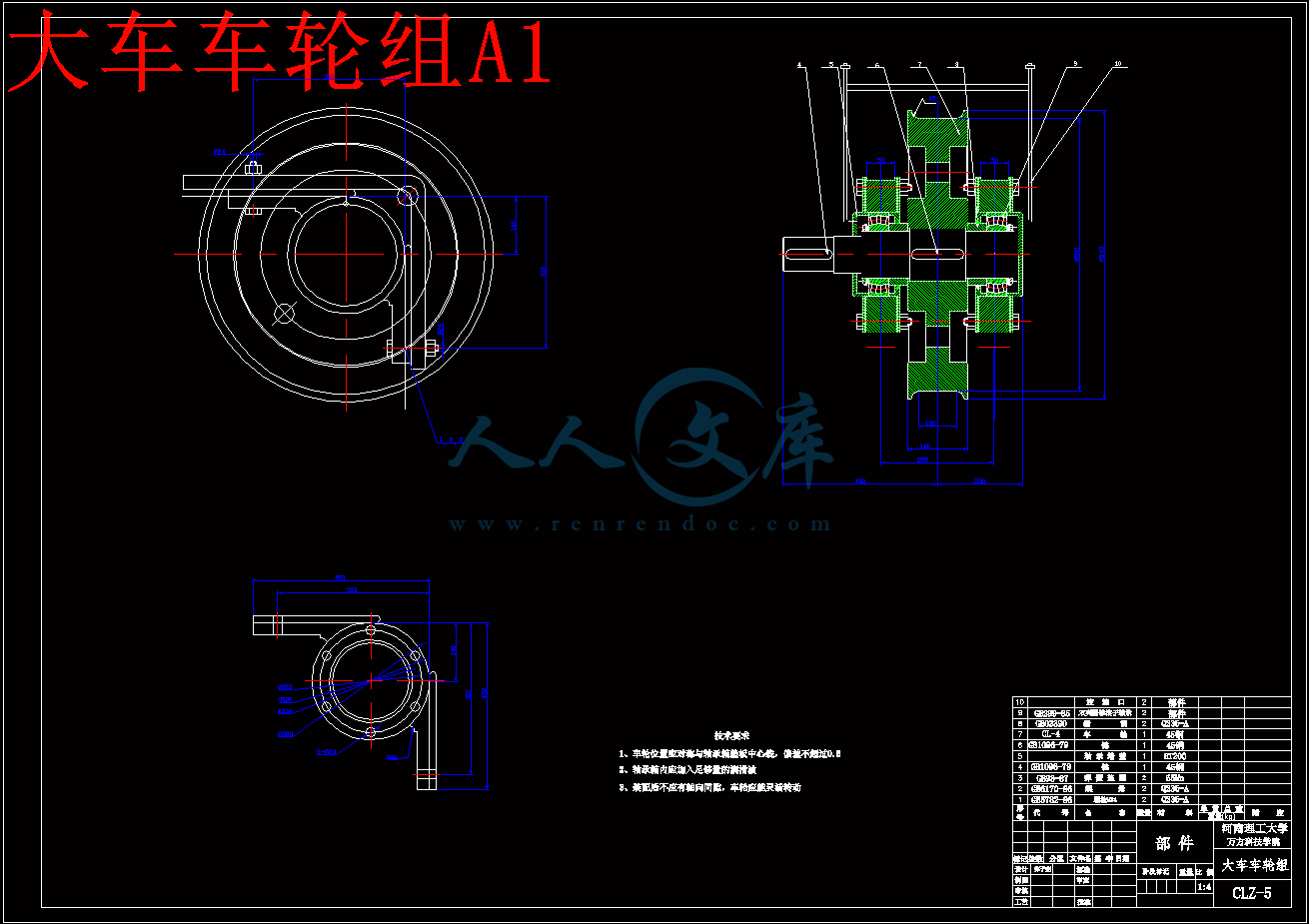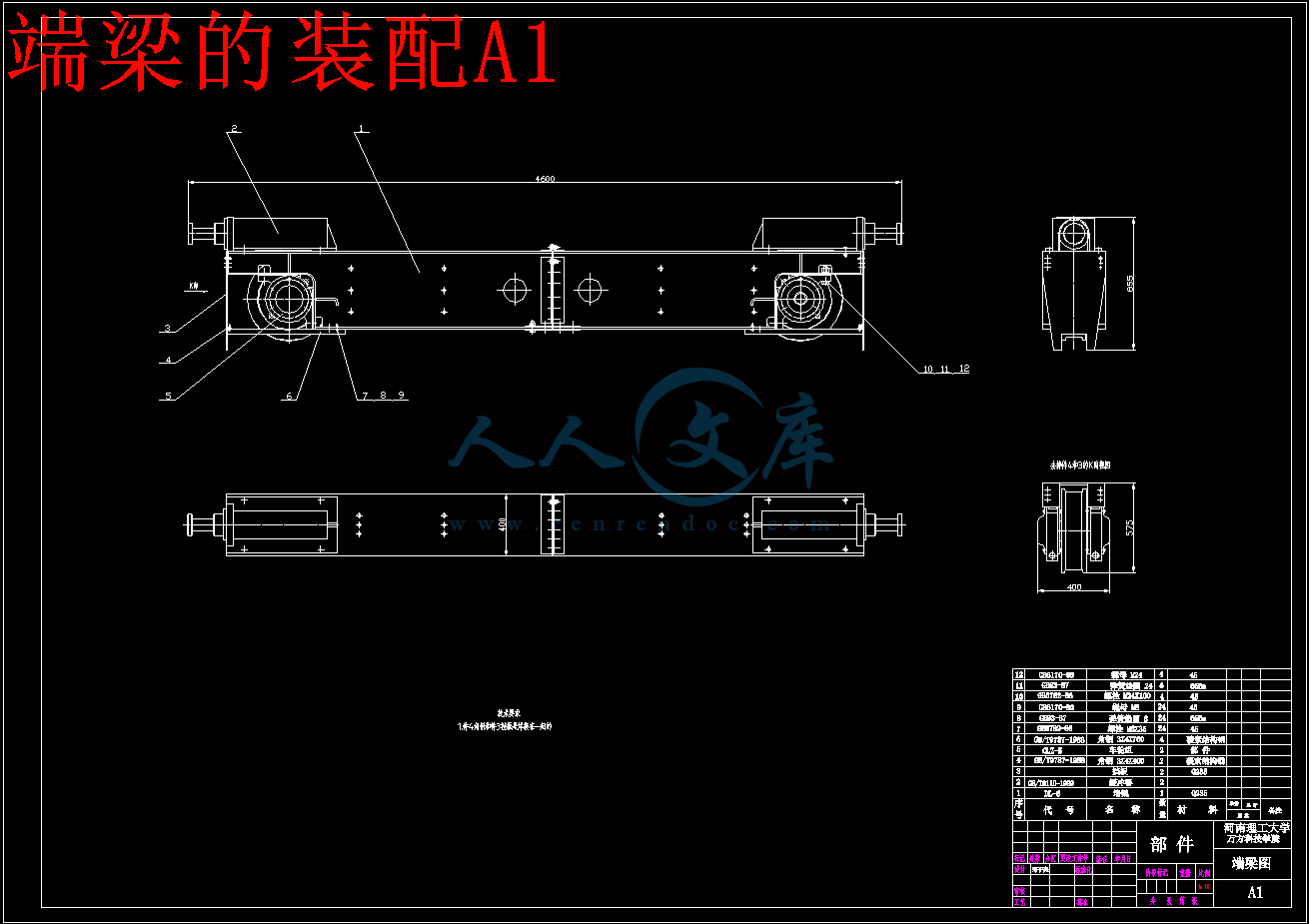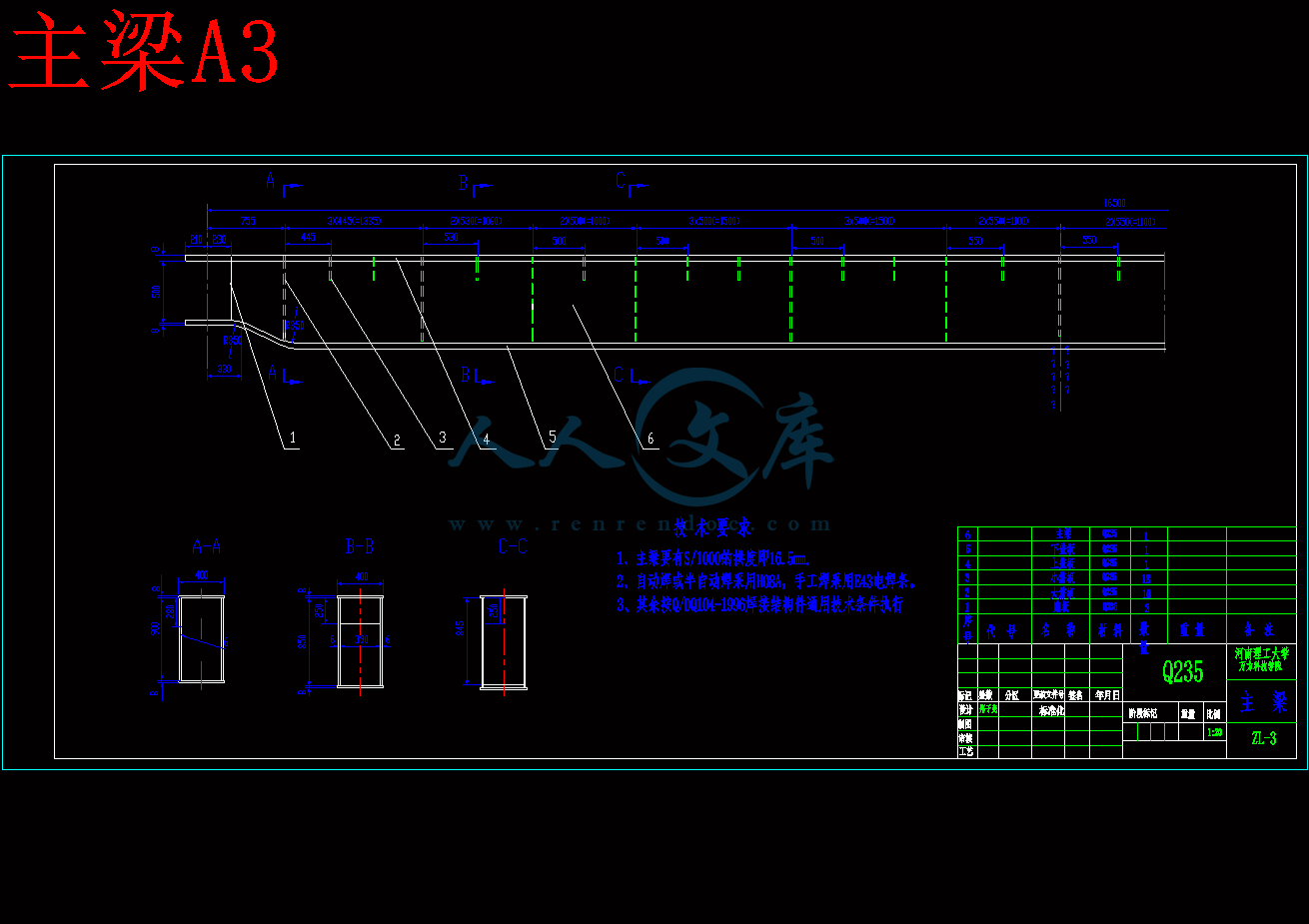10T桥式起重机总体设计
85页 21000字数+说明书+外文翻译+开题报告+7张CAD图纸
中期报告.doc
主梁A3.DWG
外文翻译--起重机的用途与历史.doc
大车车轮组A1.dwg
大车车轮轴A3.dwg
大车轮A2.dwg
大车运行机构A1.dwg
摘要.doc
端梁的装配A1.dwg
10T桥式起重机0.dwg
10T桥式起重机总体设计开题报告.doc
10T桥式起重机总体设计论文.doc
目 录
目 录I
序 言1
第1章 桥式起重机的概述2
1.1 桥式起重机分类及工作特点2
1.2 桥式起重机的用途4
1.3 桥式起重机的基本参数5
1.4 桥式起重机主要零部件6
1.4.1吊钩6
1.4.2钢丝绳8
1.4.3 滑轮和滑轮组10
1.4.4 滑轮组类型及选配原则11
1.5滑轮组及其滑轮组的倍率12
1.6 卷筒13
1.7 位置限位器13
1.8 缓冲器14
1.9桥式起重机发展概述15
1.9.1 国内桥式起重机发展动向15
第2章 大车运行机构的设计17
2.1大车运行结构设计的基本思路及要求17
2.2 大车运行机构传动方案的确定17
2.3 大车运行机构具体布置时要注意的问题18
2.4 大车运行机构的设计计算18
2.4.1 大车运行结构的传动方案19
2.5轮压计算及强度验算20
2.5.1计算大车的最大轮压和最小轮压:20
2.5.2 强度计算及校核21
2.6 运行阻力计算23
2.7 选择电动机24
2.8 减速器的选择25
2.9 验算运行速度及实际功率25
2.10 验算启动时间26
2.11 起动工况下校核减速器功率28
2.12 验算起动不打滑条件28
2.13 选择制动器31
2.14 选择联轴器32
2.15 低速浮动轴的验算32
2.16 缓冲器的选择34
第3章 起升小车的计算36
3.1 确定机构的传动方案36
3.2小车运行机构的计算37
3.3选择车轮与轨道并验算起强度37
3.4运行阻力计算39
3.5 选电动机40
3.6 验算电动机发热条件41
3.7 选择减速器41
3.8 验算运行速度和实际所需功率42
3.9验算起动时间42
3.10 按起动工况校核减速器功率43
3.11 验算起动不打滑条件44
3.12 选择制动器45
3.13 选择高速轴联轴器及制动轮45
3.14 验算低速浮动轴强度47
3.15 起升机构的设计参数48
3.16 钢丝绳的选择49
3.17 滑轮、卷筒的计算51
3.18 根据静功率初选电动机52
3.19 减速器的选择53
3.20 制动器的选择54
3.21 启动时间及启动平均加速度的验算54
3.22 联轴器的选择55
第4章 桥架结构的设计57
4.1 桥架的结构形式57
4.1.1 箱形双梁桥架的构成57
4.1.2 箱形双梁桥架的选材57
4.2 桥架结构的设计计算58
4.2.1 主要尺寸的确定58
4.2.2 主梁的计算60
4.3 端梁的计算66
4.4 端梁的尺寸的确定70
4.4.1 端梁总体的尺寸70
4.4.2端梁的截面尺寸70
第5章 端梁接头的设计72
5.1 端梁接头的确定及计算72
5.1.1 腹板和下盖板螺栓受力计算73
5.1.2 上盖板和腹板角钢的连接焊缝受力计算74
5.2 计算螺栓和焊缝的强度75
5.2.1 螺栓的强度校核75
5.2.2 焊缝的强度校核76
第6章 焊接工艺设计78
参考文献81
致 谢82
摘 要
本次毕业设计是针对毕业实习中桥式起重机所做的具体到吨位级别的设计。我国现在应用的各大起重机还是仿造国外落后技术制造出来的,而且已经在工厂内应用了多年,有些甚至还是七八十年代的产品,无论在质量上还是在功能上都满足不了日益增长的工业需求。如何设计使其成本最低化,布置合理化,功能现代化是我们研究的课题。本次设计就是对小吨位的桥式起重机进行设计,主要设计内容是10t桥式起重机的结构及运行机构,其中包括桥架结构的布置计算及校核,主梁结构的计算及校核,端梁结构的计算及校核,主端梁连接以及大车运行机构零部件的选择及校核包括: 轮压计算及强度验算, 运行阻力计算,选择电动机,减速器的选择验算,运行速度及实际功率,选择制动器,选择联轴器,低速浮动轴的验算,缓冲器的选择等计算。还有小车的运行和起升机构零部件的选择及校核包括: 运行阻力计算,选电动机,选择减速器验算起动时间,按起动工况校核减速器功率,选择制动器,选择高速轴联轴器及制动轮,验算低速浮动轴强度,钢丝绳的选择,滑轮、卷筒的计算,联轴器的选择。
关键词: 起重机;大车运行机构;小车运行结构;小车起升结构;桥架 ;主端梁 。
Abstract
The graduation design is aimed at the graduation fieldwork medium-sized crane do specific to tonnage level of design. Our country is the application of the big crane or counterfeit foreign backward technology out of manufacture and has within the plant for many years, some even application or the 70s and 80s products, both in quality and in on the function can't satisfy the growing industrial demand. How to design makes it the lowest cost, decorate rationalization, functional modernization is our topic. This design is on small tonnage design of bridge crane, the main design content is 10t bridge crane structure and operation organization, including bridge structure arrangement calculation and checking the structure of the girder, the calculation and checking, calculated and checked the beam structure, the main girders connection and cart mechanism parts selection and checking including: wheel pressure calculation and intensity checking, running friction calculation, the choice of motor, gear reducer is checked, choose speed and actual power, choose brakes, choose coupling calculating speed floating axis, buffer choice calculation, etc. And car running and lifting mechanism parts selection and checking including: running friction calculation, choose motor, choose reducer, by starting checked start-up time check reducer power, choose working brakes, choose high-speed couplings and brake wheel, the checking low-speed axial intensity, the wire rope floating choice, pulley, drum calculation, coupling choice.
Keywords: cranes; During operation organization; Car running structure; Car hoisting structure; Bridge; Main girders.
序 言
桥式起重机是横架于车间和 料场上空进行物料调运的起重设备。由于它两端坐落在高大的水泥柱或金属架上,形状似桥,所以俗称“天车”。桥式起重机是现代工业和起重运输中实现生产过程机械化、自动化的重要工具与设备,可减轻操作者的劳动强度,可大大提高生产率。桥式起重机在工矿企业、钢铁化工、铁 路交通、港口码头以及物流周转等部门和场所应用的最为广泛,是人们生产生活不可或缺的一种设备。
随着工业的迅速发展和科学技术的不断进步,桥式起重机在结构设计及自动化程度上相继出现了一些新的变化和新的特点,在结构上,国内起重设备已采用计算机优化设计,以提高起重机的机械性能,在起重质量方面逐步向大型化发展,大型桥式起重机正在钢铁、水利、发电等行业不断出现,令人世人瞩目的三峡发电厂安装了两台1200T/125T的桥式起重机,2007年9月,起重量达2万吨的桥式起重机在山东烟台佛士船厂投入使用,它标志这我国起重机行业以达到世界先进水平。
总之,随着科技的迅速发展,国内各种先进的电气控制和机械技术正逐步应用到起重机上,起重机的自动化程度越来越高,结构日趋简单,性能愈加可靠,起重量越来越大,品种也越来越全。
对于起重量大、跨距大的起重设备多采用箱型双梁式,箱型双梁桥式起重机有一个由两根箱型主梁和两根横向端梁构成的双梁桥架,在桥架上运行小车,可起吊和水平搬运各类物件。它适用于机械加工和装配车间、仓库和料场等场所。 箱型双梁结构具有加工零件少、工艺性好、通用性好及安装检修方便等优点,因而在生产中广泛使用。
第1章 桥式起重机的概述
桥式起重机是桥架型起重机的一种,主要依靠起升机构和在水平面内的两个相互垂直方向移动的运行机构,能在矩形场地及其上空作业,是工矿企业广泛使用的一种其中运输机械。它具有承载能力大、工作可靠性高、制造工艺相对简单的优点。
桥式起重机一般有大车运行机构的桥架、起升机构和小车运行机构的起重小车、电气设备、司机室等机构组成,外形像一个两端支撑在平行的两条架空轨道上平移运行的单跨平板桥。起升机构用来垂直升降物品,起重小车用来带着载荷作横向移动,以达到在跨度内和规定高度内组成三维空间里做搬运和装卸货物用。
桥式起重机是使用最广泛、拥有量最大的一种轨道运行式起重机,其额定起重量从及吨到几百吨。最基本的形式是通用吊钩桥式起重机,其他形式的桥式起重机都是在通用吊钩桥式起重机的基础上派生发展出来的。
1.1 桥式起重机分类及工作特点
桥式起重机的外观像一条金属的桥梁,所以人们称它为桥式起重机。桥式起重机俗称“天车”、“行车”。桥式起重机一般由装有起升机构和小车运行机构的桥架,大车运行机构,操纵室,小车导电装置,起重机总电源导电装置组成。
桥式起重机是在固定的跨间内装卸和搬运物料的机械设备,被广泛用于车间、仓库或者露天场地。
1.桥式起重机的分类
随着工业技术的不断发展,桥式起重机的种类越来越多,根据使用吊具不同,可分为吊钩式起重机,抓斗式起重机和电磁吸盘式起重机,根据用途不同,可分为通用桥式起重机、冶金专用桥式水电站用桥式起重机、大起升高度桥式起重机等。
按主梁结构形式可分为:箱型结构桥式起重机、桁架结构桥式起重机、管型结构桥式起重机。还有型钢和钢板制成的简单截面梁的起重机,称为梁式起重机。
2.桥式起重机的工作特点
起重机是以间隙、周期的工作方式,通过起重吊钩或其他取物装置的起升或起升加移动重物的机械设备。
综合起重机械的工作特点,,从安全技术角度分析,可概括如下:
(1)其中机械通常结构庞大,机构复杂,能完成一个起升运动、一个或几个水平运动。例如,桥式起重机能完成起升呢个、大车运行和小车运行3个运动。在作业过程中,常常是几个不同方向的运动同时操作,技术难度较大。
(2)所吊运的重物多种多样,载荷是变化的。有的重物重达几百吨乃至上前吨,有的物体长达几十米,形状也很不规则,有散粒、热融状态、易燃易爆危险品等,吊运过程复杂而危险。
(3)桥式起重机需要在较大的空间范围内运行,要装设轨道和车轮,活动空间较大,一旦造成事故其影响的范围也较大。
暴露、活动的零部件较多,且常与吊运作业人员直接接触(如吊钩、钢丝绳等),潜在许多偶发的危险因素。
(4)作业环境复杂。从大型钢铁、冶金、石化企业到现代化港口、建筑工地、铁路枢纽等,都有桥式起重机机械在运行;作业场所常常会遇有高温、高压、易燃易爆、输电线路、强磁等危险因素,对设备和作业人员形成威胁。
(5)作业中常常需要多人配合,共同进行。一个操作,要求指挥、困扎。驾驶等作业人员配合熟练、动作协调、互相照应。作业人员应有处理现场紧急情况的能力。多个作业人员之间的密切配合。通常存在较大的难度。
(6)起重机的上述工作特点,决定了他与安全生产的关系重大。如果对起重机的设计制造、安装使用和维修等环节上稍有疏忽,就有可能造成伤亡或设备事故。一方面造成人员的伤亡,另一方面也会造成很大的经济损失。
1.2 桥式起重机的用途
桥式起重机的用途和使用范围很广。它广泛应用在工业企业、港口车站、仓库料场、水电站等国民经济个部门。在冶金企业中,从原料进厂、冶炼轧制到产品出厂都需要大量的桥式起重机、加料起重机、铸造起重机等,如一个300吨转炉炼钢车间所需起重机有几十台。一个大型冶金联合企业用有数百台之多的各种类型起重机。在港口码头上,船舶货物的装卸及搬运作业,主要依靠各种起重机来完成。在一个年吐量为1500多万吨的货物港口,就约100多台各种起重机,其中,桥式起重机占有相当大的比例,在电力工业中,各种水火电站和核电站就需要大起重量的桥式起重机。在机械制造业中,企业车间内部、露天场地、仓库等场合大量应用着各种桥式起重机。
不同类型的桥式起重机所搬运的物料不同:吊钩起重机搬运各种成件物品;抓斗起重机搬运各种散粒物品,如煤、焦炭、砂等;电磁起重机搬运导磁的金属材料,如型钢、钢板、废钢等;两用起重机是为了生产效率,在一台小车上装有可换的吊钩和抓斗或者电磁吸盘和抓斗,但每一个工作循环只能使用其中的一种取物装置,可运送成件、散粒物品或者到此的金属材料,但每次搬运物品时,只能使用其中一种;防爆起重机用于搬运有易爆气体或有易爆介质的车间、库房等场所的成件物品,起重机上的电气设备和有关装置具有防爆特性,以免发生火花;绝缘起重机用于搬运电解车间的各种成件物品,起重机上有关部分具有可靠的绝缘装置,保证安全操作。
1.3 桥式起重机的基本参数
桥式起重机的技术参数是桥式起重机工作性能的指标。桥式起重机的主要技术参数包括:起重量、跨度、起升高度、各机构的工作速度以及工作级别等,为了保证桥式起重机的合理使用、安全运行和防止事故的发生,桥式起重机司机必须掌握桥式起重机的技术参数。
主要参数:
起重量
起重量是指被起升重物的质量,用G表示。
(1)额定起重量 起重机所允许吊起的最大重物或者物料的质量称为额定起重量,用Cn表示,单位用吨(t),额定起重量不包括吊钩、吊环之类吊具的质量,但包括抓斗、电磁盘、盛钢桶、料罐之类可分吊具的质量。
(2)总起重量 起重机能吊起的重物或物料,连同可分吊具和长期固定在起重机上的吊具或属具(包括吊钩、滑轮组、起重钢丝绳…….)等质量总和,总起重用Gt表示。
跨度和轨距
桥式起重机的大车运行轨道中心线之间的距离称为桥式起重机的跨度,用L表示,单位为m。桥式起重机的小车运行轨道两条钢轨中心线之间的距离为小车轨距,用t表示,单位为m,跨度依厂房的而定。
起升高度
起升高度是桥式起重机取物装置上下移动极限位置之间的距离,用H表示,单位为m。下极限位置通常以工作场地的地面为准,上极限的位置,使用吊钩时以钩口中心为准,使用抓斗时以抓斗最低点为准。
工作速度
工作速度是指起重机个机构(起升、运行)的运行速度,其中:额定起升速度是指起升机构的电动机在额定转速下,取物装置的上升速度;小车额定运行速度是指小车运行机构电动机在额定转速下的小车运行速度;大车额定运行速度是指大车运行机构的电动机在额定转速下的运行速度。各类速度用v表示,单位为m/min。桥式起重机的工作速度根据工作要求而定:一般用途的桥式起重机采用中等的工作速度,这样可以使驱动电机功率不致过大;安装工作有时就要求很低的工作速度;吊运轻件,要求提高生产效率,可取较高的工作速度啊;吊运重件,要求工作平稳,作业效率不是主要矛盾,可取较低的工作速度。
起重机的总质量G
包括燃料、油液、润滑剂和水等在内的起重量各部分质量的总和,单位用t表示。
外形尺寸
外形尺寸指起重机长、宽、高的的尺寸,单位用m表示。第2章 大车运行机构的设计
2.1大车运行结构设计的基本思路及要求
大车运行机构的设计通常和桥架的设计一起考虑,两者的设计工作要交叉进行,一般的设计步骤:
1. 确定桥架结构的形式和大车运行机构的传方式;
2. 布置桥架的结构尺寸;
3. 安排大车运行机构的具体位置和尺寸;
4. 综合考虑二者的关系和完成部分的设计 。
对大车运行机构设计的基本要求是:
1. 机构要紧凑,重量要轻;
2. 和桥架配合要合适,这样桥架设计容易,机构容易布置,且使总体结构设计和布置不至于过大;
3. 尽量减轻主梁的扭转载荷,不影响桥架刚度;
4. 维修检修方便,机构布置合理,使司机和维护人员上下要方便,便于拆装零件及操作。
2.2 大车运行机构传动方案的确定
大车机构传动方案可分为两类:即分别传动和集中传动,桥式起重机的跨度介于10.5m-32m范围内可用分别传动的方案,本设计采用分别传动的方案。
2.3 大车运行机构具体布置时要注意的问题
1. 联轴器的选择;
2. 轴承位置的安排;
3. 轴长度的确定;
这三者是互相联系的,在设计过程中要考虑到其中各个部分的配合,做到相互兼顾,充分发挥各个零部件的作用。
在具体布置大车运行机构的零部件时应该注意以几点:
(1)因为大车运行机构要安装在起重机桥架上,桥架的运行速度很高,而且受载之后向下挠曲,机构零部件在桥架上的安装可能不十分准确,所以如果单从保持机构的运动性能和补偿安装的不准确性着眼,凡是靠近电动机、减速器和车轮的轴,最好都用浮动轴。
(2)为了减少主梁的扭转载荷,应该使机构零件尽量靠近主梁而远离走台栏杆;尽量靠近端梁,使端梁能直接支撑一部分零部件的重量。
(3)对于分别传动的大车运行机构应该参考现有的资料,在浮动轴有足够的长度的条件下,使安装运行机构的平台减小,占用桥架的一个节间到两个节间的长度,总之考虑到桥架的设计和制造方便。
(4)制动器要安装在靠近电动机,使浮动轴可以在运行机构制动时发挥吸收冲击动能的作用。
参照以上所述,由于所设计的参数级别较大,跨度中等,所以采用分别传动方案。
2.4 大车运行机构的设计计算
设计数据:
起重机的起重量Q=10T,桥架跨度L=16.5m,大车运行速度Vdc=80m/min,工作类型为中级,机构运行持续率为JC%=25,起重机的估计重量G=168KN,小车的重量为Gxc=40KN,桥架采用箱形结构。
2.4.1 大车运行结构的传动方案
经各方面综合考虑传动方案选用分别驱动,其传动路线如下图2-1所示
参考文献
[1] 《起重机设计手册》 起重机设计编写组,机械工业出版社,1980
[2] 《机械设计师手册》 吴宗泽主编 机械工业出版社,2002
[3] 《起重机课程设计》 陈道南、盛汉中主编 冶金工业出版社,1983
[4] 《焊接手册》中国机械工程学会焊接学会编,机械工业出版社,1992
[5] 《 起重运输机械》 张质文 、刘全德 中国铁道出版社 1983年
[6] 《 机械原理》 孙桓、 陈作模 高等教育出版社 1996年
[7] 《 工程起重机》 顾迪民 中国建筑工业出版社,1988
[8] 《 机械设计》 濮良贵、纪名刚 高等教育出版社,2000.12
[9] 《机械零件手册》 周开勤 高等教育出版社,2000.12
[10] 《机械设计课程设计手册》 吴宗泽、罗圣国 高等教育出版社,2006.5







 川公网安备: 51019002004831号
川公网安备: 51019002004831号